Must be Packard week. Here’s a post-war Packard this time, listed on craigslist for $8000 firm. The new owner can collect this car from Springfield, Missouri. Dan gave us this tip – thanks, Dan! I believe the model/trim level here is a 1950 Deluxe Eight, but I had to guess since the seller doesn’t say. Packard made several forms of “Eight” in 1950, not to mention many body styles and submodels of each. Many were differentiated by trim level or wheelbase. The Deluxe Eight provided buyers with fancy door cap trim (check), carpet (yup), and a partially chromed steering wheel (ditto). The Eight on a 120″ wheelbase was sold alongside the Super Eights and Custom Eights at 127″. The larger cars were given more powerful engines, qualifying them as “senior” cars, while the little Eights were “juniors”. The very existence of junior cars was galling to many Packard customers, who felt that the light cars cheapened the brand that cost them so dearly. While many blame Packard’s demise on its attempt to market to both ends of the market, it also employed “upside down bathtub” styling for too long. A facelift in 1951 wasn’t enough to save the company: production petered out in 1956 and the company name lived on only peripherally as part of Studebaker.
The engine is Packard’s normally faithful 288 cu. in. in-line eight-cylinder, with fuel handled by a two-barrel Carter carburetor. This setup was good for 135 hp. A three-speed manual brings the power to the wheels, but advancing into the Packard line was its Ultramatic automatic, notable because it was developed completely in-house. Today, a manual is more desirable in the market. While the underhood real estate looks quite spiffy, the motor has turned unfaithful by losing compression in three cylinders: the seller thinks the head gasket is blown. Meanwhile, the car was treated to a new gas tank, rebuilt carb, and new brakes before the engine decided to stop compressing.
The interior is clean enough from what we can see, but I’d want to give those carpets a thorough shampooing. The glass is said to be good except for a small crack in the driver’s door window. Split windshields were just starting to phase out in favor of a single piece of curved glass; Packard adopted the curved windshield in 1951.
The chrome is great, though the paint is showing dullness – hard to tell whether it can be brought back but my experience is that most paint coats can be improved at least a little. The seller notes that the car is rust-free. The front end suggests that ingress was required at some point through the grille – perhaps a stuck hood latch? Here’s what that chrome jewelry should look like! As to value, good drivers sell in the low to mid-teens. If the cost of fixing that engine can be controlled, the seller’s asking price seems reasonable to me; what do you think?




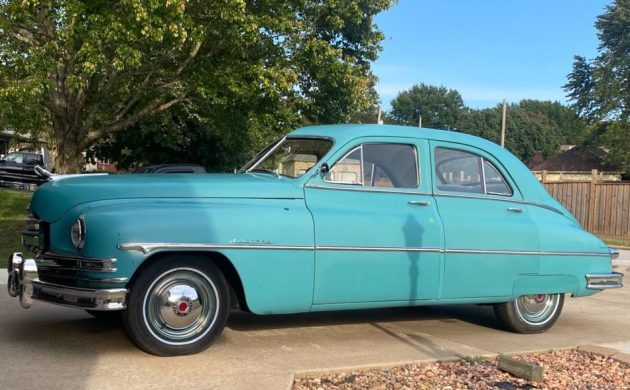



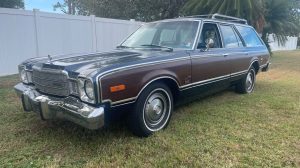
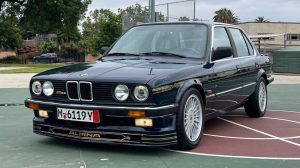
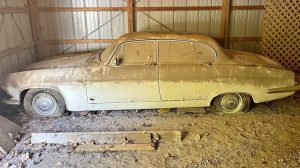
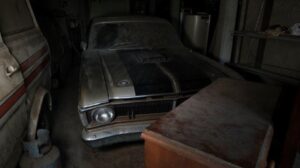


I don’t mean to take center stage on these posts, it is rather uncanny how many posts hit home though. For the benefit of the author, or some that have just started here, since the last Packard post, that is, this is pretty darn close to ours. Briefly, my grandfather bought his 1st new car, a Custom 8 in 1948, cost $2808,( when a Ford was half that) mainly because of their contributions to the war. My dad found our Packard in 1980, in a back yard on blocks. The widow said her late husband parked the car with 41K miles, when he refused to pay over .25/gallon in 1959. It was very similar, a ’50 Standard 8, but had the automatic, new for 1950. As a testament to Packard, after all that time sitting, 21 years outside, a refreshing was all that was needed, including the trans, kind of. They didn’t shift right from new, but WAS the 2nd fully automatic in America. I say, it can’t be a head gasket, as those things were as thick as a country phone book. I bet it’s stuck valves, and does not have the O/D, like my grandfather had. While the “upside down bathtub” remarks define the car to some, many cars were upside down bathtubs, and “pregnant elephant”, not much better. Almost an insult to many owners. These cars, I can personally attest to, were not a “sacrifice” for a cheaper Packard. There was no such thing, as mentioned before, ALL Packards had quality components. They cost more for a reason, and every buyer that bought a Packard, even to the bitter end, wanted a Packard for what they were, simply one of the best. Ask the PERSON( updated for today) who own(ed) one.
HoA: Here we go again :) The BF 1950mPackard owners club . If I wasn’t so financially disadvantaged ( read : cheap) I could post a polaroid of my ’50 Pakard Super 8 Ultramatic, my first car in 1970 as a sixteen year old car nut.
As recounted numerous times, it was a Doctors car, top of the line Ultramatic with a Mohair interior and the sweetest lap robe cord spanning the rear of the front seat.
Of course one day the tranny gave out just as I was (seriously) going to drive it from the East Coast to Colorado where I was headed to live the life of a Mountainman LOL!……in a black 1950 Packard! Kids!
Drove it BACKWARDS a few miles home, where it ended up in an Aamco yard in Bridgeport Conn. When you cracked the case on those trannies as I was told, they came apart in your hands. An Aamco exam became a rebuild without my ok.
Since the old man was going to teach me a lesson and I didnt have the money to retrieve it or the knowledge to sue the bastids, it sat until the old man relented and sued for an action in replevin. It had lost it’s Cormorant and a few hubcaps in the Aamco yard and I sold it then headed off to the mountains.
Cue some lame sad music :)
In the 1960s and well into the late 1980s, AAMCO had earned a terrible reputation because the parent company didn’t police their franchise holders, and many AAMCO shops didn’t treat the customer with respect [I’m being gentle here as AAMCO is still in business]. Today AAMCO shops in general are far more reputable than before.
I bought many a Packard with a recent AAMCO Ultramatic transmission rebuild that had failed not long after the rebuild, and most times I found that what had been done was to simply tighten up the band and clutch adjustments, & slap it back together. I’ve heard from another very reliable Packard “expert” [but not actually seen it] where all the company did was steam clean the unit while still in the car, pull the pan and do some adjustments, but charge for a full rebuild.
As for this featured Packard it is probably a Deluxe Eight. Without the VIN available, about the only way one can know if it’s a Deluxe 8 or the Eight is the Deluxe has a center fold-down rear seat armrest. The VIN would have a serial number beginning with 2362. If it was the cheaper Eight sedan, it would be a 2392.
On this Packard, The first 2 VIN digits denotes the 23rd series [1949-50] The 3rd digit refers to the model, and the 4th digit denotes the body style. To separate the 1950 cars, they added a -5 to the VIN, then the actual serial sequence number. For this car it should be 2362-5-XXXXX
There is no difference to be seen from the outside. The Eight had a fairly flat “winged” hood ornament, and the Deluxe had a streamlined [almost art-deco] upright chrome wheel. But to confuse this is the wheel type ornament was an option for the Eight as well! This car displays the most expensive “Cormorant” ornament.
I find it interesting that this car does not have a factory radio, but it does have the hole in the left front fender where the optional power [Vacuum] antenna was located. I suspect the front fender may have been replaced and was from a car that had the power antenna. The hole for the vacuum antenna is larger than the regular antenna base hole. I can’t see the driver’s side of the firewall to see if the holes for the vacuum lines are there, or if the antenna switch is at the base of the dashboard.
As for the possible head gasket leak, It’s fairly unusual for the Packard eight engines to develop head gasket leaks, but if this car had a lot of motor repairs done recently, the problem could be that it was not re-torqued after 500 miles, and it may be as simple as using a torque wrench to tighten it back down to the correct specs.
The few Packard eight engines I’ve seen with leaking head gaskets, all had coolant leaks as well. The good news is Packard used the same head gasket 1948 to 1954, for the 288, 327, and 356 engines [but not the 1954 359 motor with the aluminum head.]. There are ample supplies of these gaskets at very reasonable prices.
I always wanted one in this style but found a 56 400 2 door. I sold my 56 Coupe Deville to buy it. Yes it was a better car.
Hi Mw, I never tire of Packard stories, now on to the black one,,:)
BTW…on the issue of the supposedly blown head gasket on this one. I will give the seller the benefit of the doubt that he knows what he speaks of. I try to be polite :) BUT…….I agree with you based on personal experience.
When I was sold the Packard by my Dad for $250.00 (1970 dollars I might add) it had sat abandoned for some reason in my grandfather’s garage. Anyway once it was towed home, we had to soak the cylinders in Marvel Mystery Oil for days.of course it was an unheated garage in sub freezing weather in winter.:) So it might be that his cylinders are stuck…it is a Packard. I would also worry about that tranny :)
“Blown Head Gasket”
Check the seal. (old joke)
I’ve got a 50 Standard. Really like the look of acorn nuts on the head. Ordered a set (NOT from Kanter!) and installed them. Looked great! Drove it about 50 miles, blew head gasket. Pulled head and had it surfaced, checked block for true, got new gasket and reinstalled. Ran great for about 50 miles, then blew head gasket again. Pulled head to see what the problem was. Seemed like the head nuts were easy to remove, only visible problem was blown head gasket. Turns out that the chrome washers supplied in the kit were too soft! Even though the nuts were correctly torqued (Twice!), after running for a while the washers crushed enough to allow head gasket to blow. Lesson learned!!
Where was the extra 8 inches on the senior cars? Longer front end maybe? I know they made a factory limo but not everyone wanted one of those. This one looks pretty good, but I wonder if that is the original color. It doesn’t seem to go with interior. I think it would look good in black or maybe burgundy. The rest of it looks nice and if you can do the motor work yourself, save some money there. Working on this should be breeze to anyone who has worked on modern overhead cam motors where you can’t even see the head when you lift the hood
Hi geezer, not sure, but I think they had a longer hood and fenders to accommodate the longer motor. On one of my parts cars, that were Standards, someone cobbled in a 356 motor and had to relocate the radiator forward.
Since I’m here, the grill was not damaged in an attempt to open it. These hoods were hinged at the sides, like an IH pickup, and opened either side, or removed completely.
If it is stuck valves as, Howard suggests, it could be cured possibly with some additive to the oil. That would be sweet to bring it back to life with a $20 can of something and have a awesome car to cruze in.
More than one “needs a valve job” situation has been cured with a bottle of Marvel Mystery Oil. Pour half of the bottle in the tank, a quarter in the crankcase and the rest down the carb throat with the engine running and the throttle halfway open. It might just do the trick.
A: “How does it work?”
B: “It’s a mystery, it just does.”
A: “I see…”
Probably wasn’t a stuck hood latch. These hoods weren’t hinged at the back. There’s a lever under the dash on both the driver’s and passenger’s side that allows the hood to be opened from either side. Heck, you could push both levers and just lift the hood off!
It could have been somebody unfamiliar with the hood release trying to pop the hood open. My ’52 Buick was also a side opener and back in the day, service station attendants would try & open the hood from the front.
So, it’s either a can of Marvel Mystery Oil, and a fluff n’ buff. Or, a rebuild and a paint job.You pays your money? You takes your chances.
Pre-55 cars are in such low demand among people under the age of 60, coupled w the current economy; this car would be a great deal closer to the 4-5k mark
last of the classics here (late 30s thru early 50s). Fave motors there (any i8) too bad on the ‘burn’ but chance to machine to it’s betters. Great colors (T on white. I think I’d green out the brn). Thnx Michelle, 1 of ur betters~
Let’s pull the head off and look at what’s really going on. If it’s just a head gasket, OK, but looking at the valves and the tops of the pistons is in order. My Super 8 always had over heating issues in summertime, that head can get really hot!
Kurt [and other BF members],
Engines of the straight-8 design [& some straight 6] often have an overheating problem where the actual overall temperature of the coolant is under the boiling point, but due to sludge & dirt build-up in the water jackets around the back 2 cylinders, the water temperature at the very back of the engine can become hot enough to make it boil.
NOTE: If you have access to a digital thermal camera, it’s easy to see if the back cylinders are running too hot.
The resultant steam [AIR!] will pressurize the entire cooling system beyond the cap’s limits, making the coolant system act as if ALL the water is over the boiling point, when in fact it’s just the water at the back of the engine..
If the water pump, thermostat & hoses are in good condition, and the radiator still has decent flow rates, but the car still “runs hot”, the overheating problem may be a problem with the water distribution tube.
This tube [usually of stamped & formed brass or copper*] directs water down along all 8 cylinders, with a series of holes directing water towards the cylinders. The holes are smaller at the beginning [cylinder #1] and become larger, with the largest holes at the last [cylinder #8]. This design is meant to maintain the basic water pressure & flow all the way down the tube.
* Some engines were equipped with steel distribution tubes in early 1945 and again during the Korean War when copper/brass was restricted for military use. It is unlikely any steel tubes exist in engines today, they’ve either been replaced or they rusted away to nothing!
The problem boils down [pun intended] to 2 basic situations:
1. The holes in the tube become clogged with dirt, sediment, old pieces of gasket, etc. As the water flow tends to move slower at the back, those rearward holes tend to get blocked.
2. Because the water is moving slower towards the rear of the cooling passages, sediment tends to collect there over a long period of time.
The removal of the tube also requires the water pump, fan, and radiator to be removed, and usually the center grill section, as the distribution tube is about the same length as the engine block. The tube can be found at the point where the water pump is funneling cooled water into the engine block.
The tube can be pulled out and checked for blocked holes. Once the tube is cleaned, the next step is to remove the “freeze” plugs, and clean out all the sediment from the cooling passages. This sediment typically looks like fine sand. I find that taking a compressed air blow-gun with a 6 to 10 inch flexible line on the front, combined with a steady flow of water directed at the passages, will cause most of the sediment to dislodge & come out with the water.
[This job, while not terribly difficult to perform, IS quite messy, so dress appropriately, as you’re gonna get dirty & wet!]
This style of Packard has to be the ugliest ever produced, maybe knock a zero off the price…
To each their own I guess, I find the design stunning
pwtiger,
The 1948 Packard won all 8 of the automotive styling & design awards that year, and a full size example of the Super 8 convertible was placed on display in the prestigious Museum Of Modern Art [MOMA] in New York City.
The problem was, styling and fashion evolved very fast in the first 15 years after WW2. Within 2 to 3 years the slab sided, monochromatic look began to be eclipsed by the bright colors inside and outside of the cars, along with what many now consider garish applications of chrome and stainless steel.
I’ve owned almost every example of the 22 & 23rd series Packards, from the lowly 6-cylinder Taxicab, to the Custom Super 8 limousine, and still have a 1948 Super 8 convertible. Yes, over many decades they generally garner that “I like it” or “I hate it” type of comments, but over the years the comments were probably about 80% “I like it.”
Just read Bill McCoskey post, and for some reason there’s no “Reply” button on it.. You guys should pay attention to Bill, he probably knows more than just about anybody alive about Packards!
If you find yourself in need of an Ultramatic rebuild, here are a couple that I know from experience are good. Ultramatic Dynamics in Virginia is outstanding, and I think he may have exchange trannys in stock. Greenville Transmissions in South Carolina is also very good, owner is a noted Packard collector and does a nice job as well.
Bill, If you read this, I thought that the “Egyptian” was the most expensive hood ornament for the 23rd series? Originally cost about $9.00, A good one today would probably cost $500.00-1000.00!
It’s a shame the history and info posted on old “treasures” can’t be archived somehow for future researchers.
I’m 80 and have seen a lot of the old treasures I remember from my youth. I wish I had the $$$ resources and space to save a few.
My first car was a ‘54(?) buick sedan in’61 when I graduated hs. Great drive in car. You could sit in back seat and not front seat. Don’t remember model, but it had 3 portholes aside.
Broke a pitman arm, went to junkyard and got another, straightened tires out, screwed in pitman arm to grease marks. Took it out to a straightaway and did 115mph, no wiggle. Was lucky.
It seemed good styling was being lost in late 60’s.
Also had a couple of triumphs3b and 4a. Another story.